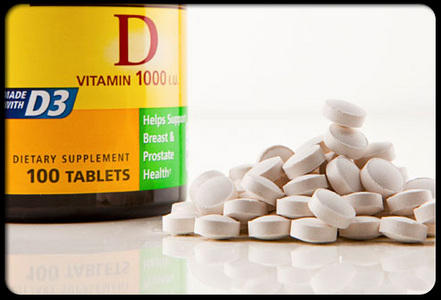Vitamin D is very important for the human body as it plays an important role in various functions of the organism, such as calcium absorption from the gastrointestinal system, muscle health, heart health, bone health, immune function, etc. Vitamin D is commonly found in various foods we consume daily, but the human body can produce vitamin D itself as well when it is being exposed to sunlight. However, many people don’t get enough vitamin D, so vitamin D supplements are often recommended. In certain cases, even though rare, an overdose of vitamin D can occur, reaching toxic levels in the human body.

What Counts as Vitamin D Overdose?
Normally, it will take some time for an overdose to occur. It is impossible for an overdose to occur from a single large dose of these vitamin supplements. The human body accumulates the vitamin D in fat cells all over the body, where it can reach toxic levels over a long period of time. There is a maximum dose of vitamin D a person can consume a day, commonly known as the Upper Intake Level.
According to the National Institute of Health, the Upper Intake Level of vitamin D for people of a certain age is as follows:
|
Age |
Male |
Female |
Pregnancy |
Lactation |
|
0 – 6 months |
1,000 IU |
1,000 IU |
/ |
/ |
|
7 – 12 months |
1,500 IU |
1,500 IU |
/ |
/ |
|
1 – 3 years |
2,500 IU |
2,500 IU |
/ |
/ |
|
4 – 8 years |
3,000 IU |
3,000 IU |
/ |
/ |
|
9 – 18 years |
4,000 IU |
4,000 IU |
4,000 IU |
4,000 IU |
|
+ 19 years |
4,000 IU |
4,000 IU |
4,000 IU |
4,000 IU |
Long-term ingesting of vitamin D supplements above the maximum dosage for a certain age will lead to various adverse health effects and even to the development of vitamin D toxicity. A vitamin D toxicity threshold is when 10,000 to 40,000 IU of vitamin D is taken on a daily basis.
What Happens When You Overdose On Vitamin D?
Common signs and symptoms of vitamin D overdose include:
- Nausea
- Vomiting
- Thirst
- Dehydration
- Increased urination
- Loos of appetite
- Weight loss
- Muscle weakness
- Constipation
- Confusion
- Heart arrhythmia
All the above-mentioned signs and symptoms are not specific for overdose of vitamin D, but they could signify various medical conditions. For this reason, sometimes diagnosing the overdose is not that easy.
A person should be tested for overdose by looking at the levels of calcium in the serum and urine. The levels of 25-hydroxyvitamin D should be measured as well. If these levels are higher than 150 ng/ml, then this should be a concern. Also, the levels of parathyroid hormones should be measured, as these two are related.
Once an overdose is diagnosed, it is very important to stop taking these vitamin supplements immediately. If a person continues to take vitamin D supplements despite the overdose, permanent kidney damage and other health problems will occur. Rarely, the overdose can lead to fatality due to abnormal electrolyte levels, heart arrhythmia, and dehydration.
How to Deal with Vitamin D Overdose
In cases of an overdose, there are various treatments available, depending on a person and the individual requirements for vitamin D. Some of the treatment options include avoiding a further consumption of these vitamin D supplements, dietary restriction, loop diuretics, glucocorticoids, intravenous saline hydration, etc.
Discontinuation of Vitamin D Intake
Once an overdose develops, it is very important to immediately stop taking further vitamin D supplements. Also, a person should not expose himself/herself to sunlight, as it is known that sunlight contributes to the production of vitamin D from the human body.
Intravenous Saline Hydration
In cases of an overdose, hypercalcemia is common. For this purpose, in order to minimize the adverse effects, intravenous saline hydration, calcitonin and bisphosphonates are used. The recommended dosage of intravenous saline hydration is determined based on the severity of hypercalcemia, the overall health of the patient, age, etc.
Loop Diuretics
Medications like loop diuretics are also recommended for the treatment of vitamin D overdose. These medications help in the absorption of calcium from the intestines, alleviating the adverse effects of vitamin D toxicity.
Restriction of Calcium and Phosphorus Intake
It is necessary to restrict the intake of calcium and phosphorus as the human body will already be under a hypermetabolism of these two elements. Certain foods that are rich in calcium and phosphorus should be avoided such as milk, yogurt, cheese, white beans, soybeans, pumpkin seeds, Brazil nuts, salmon, scallops, etc. until the overdose problem is solved.
Glucocorticoids
Glucocorticoids are recommended for the treatment of vitamin D toxicity as they reduce the production of calcitriol. Calcitriol is the active form of vitamin D. Glucocorticoids also work by delaying the absorption of the calcium in the renal tubes, balancing this way the levels of calcium in the human body as much as possible.
Recommended Daily Intake of Vitamin D
Recommended dietary allowance of vitamin D for a certain age is as follows:
|
Age |
Male |
Female |
Pregnancy |
Lactation |
|
0 – 12 months |
400 IU |
400 IU |
/ |
/ |
|
1 – 13 years |
600 IU |
600 IU |
/ |
/ |
|
14 – 18 years |
600 IU |
600 IU |
600 IU |
600 IU |
|
19 – 50 years |
600 IU |
600 IU |
600 IU |
600 IU |
|
51 – 70 years |
600 IU |
600 IU |
/ |
/ |
|
+ 70 years |
800 IU |
800 IU |
/ |
/ |
